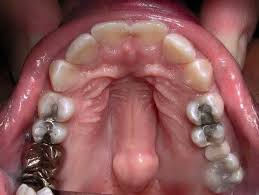 A bony protrusion or exocytosis that affects the midline of the hard palate or roof of the mouth.
A bony protrusion or exocytosis that affects the midline of the hard palate or roof of the mouth.
The lesions can appear lobular, nodular, or spindle-shaped in appearance.
Approximately 20% of the population has at least a small lesion, which may not be noticed until middle age.
The lesions extend symmetrically from the midline.
Lesions are on the average about 2 cm in size and grow slowly.
Clinically appears smooth, broad-based, firm and has normal overlying mucosa.
While single lesions are most common, multiple lesions may be present.
More frequent among females.
Occurs twice as often in women as in men.
Increase frequency in Asians, Native Americans, and Inuit Eskimos.
Etiology thought to be genetic.
With advancing age the size of the lesions may decrease as bony resorption occurs.
May be associated with irritation from trauma, and secondary ulcerations, infection and bleeding may occur.
May interfere with the utilization of dentures.
Rarely requires treatment, which involves removal of the bony protuberance with surgery.
